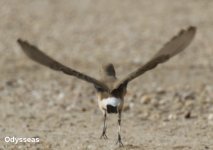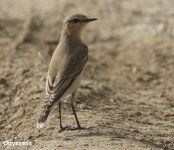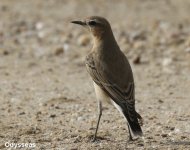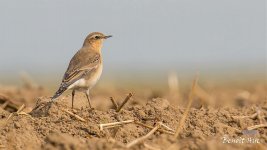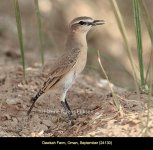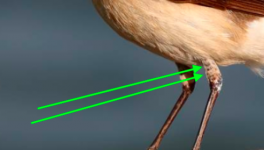-
Welcome to BirdForum, the internet's largest birding community with thousands of members from all over the world. The forums are dedicated to wild birds, birding, binoculars and equipment and all that goes with it.
Please register for an account to take part in the discussions in the forum, post your pictures in the gallery and more.
You are using an out of date browser. It may not display this or other websites correctly.
You should upgrade or use an alternative browser.
You should upgrade or use an alternative browser.
Isabelline Wheatear , Northern Greece (1 Viewer)
- Thread starter ody
- Start date
More options
Who Replied?lou salomon
the birdonist
no, it's a northern. issy is white in front of the eye not behind. and it doesn't show these contrastingly dark centered median coverts.
Brian J Small
Well-known member
Ody
Isabelline for me. Limited white on rump; tail pattern; primary extension and spacing; tertial edges; etc..
B
Isabelline for me. Limited white on rump; tail pattern; primary extension and spacing; tertial edges; etc..
B
Tib78
Well-known member
Hi Brian,
It is a tricky bird and some of the features you listed do favour Isabelline indeed (and I would also add the uniformely pale cheek/ear coverts!). However I just can’t get past the Northern impression I gather from this bird. And in my view, some of the characters you mentioned, such as the extent of white to the rump, are debatable. Also I don’t think the tail pattern is of any help with the images provided, as it is not spread.
The blackish center to median coverts mention by Lou are indeed a strong pointer to Northern and so are the contrasty lesser coverts.
Anyway here are the pro-Northern criteria that I see in this bird:
- on the open wings shot the rump is exposed and appear uniformly dark brown as opposed to paler tawny in Izzy with the lower part of the rump often sporting a richer peachy cast in this species
- the 2 or 3 innermost greater coverts have neat and contrasting white tips (should be buffy, less sharply defined and less contrasting in Izzy)
- the mantle is on the darker side for Izzy with a lot of grayish feathers mixed in
- the alula doesn’t appear particularly darker than the center of the greater coverts
- an Izzy in fresh plumage would typically show broader pale fringe to the primaries
- the tertials fringing is narrow too for a fresh plumaged bird (compare this feature and the previous one to: http://orientalbirdimages.org/search.php?Bird_Image_ID=128330&Bird_ID=2581&Bird_Family_ID=&Location= and http://orientalbirdimages.org/search.php?Bird_Image_ID=126271&Bird_ID=2581&Bird_Family_ID=&Location= , one more : https://www.hbw.com/ibc/photo/isabelline-wheatear-oenanthe-isabellina/standing-rock-0
- the bill isn’t particularly chunky
- the tights feather have black fleckings
Regarding the primary tips spacing: in theory it does favour Izzy but a quick google reveals a few Northern with a very comparable wing tip: http://home.earthlink.net/~pomarine4/id23.html
See also the image attached (copyright Benoit Huc)
And actually on many Isabelline the tip of P5 is even closer to P4 than on the subject bird.
The projection projection is on the long side for an Isabelline but probably within variation (and on the short side for Northern but probably...).
So here goes my opinion: a tricky bird but the overall impression is wrong for Isabelline...
It is a tricky bird and some of the features you listed do favour Isabelline indeed (and I would also add the uniformely pale cheek/ear coverts!). However I just can’t get past the Northern impression I gather from this bird. And in my view, some of the characters you mentioned, such as the extent of white to the rump, are debatable. Also I don’t think the tail pattern is of any help with the images provided, as it is not spread.
The blackish center to median coverts mention by Lou are indeed a strong pointer to Northern and so are the contrasty lesser coverts.
Anyway here are the pro-Northern criteria that I see in this bird:
- on the open wings shot the rump is exposed and appear uniformly dark brown as opposed to paler tawny in Izzy with the lower part of the rump often sporting a richer peachy cast in this species
- the 2 or 3 innermost greater coverts have neat and contrasting white tips (should be buffy, less sharply defined and less contrasting in Izzy)
- the mantle is on the darker side for Izzy with a lot of grayish feathers mixed in
- the alula doesn’t appear particularly darker than the center of the greater coverts
- an Izzy in fresh plumage would typically show broader pale fringe to the primaries
- the tertials fringing is narrow too for a fresh plumaged bird (compare this feature and the previous one to: http://orientalbirdimages.org/search.php?Bird_Image_ID=128330&Bird_ID=2581&Bird_Family_ID=&Location= and http://orientalbirdimages.org/search.php?Bird_Image_ID=126271&Bird_ID=2581&Bird_Family_ID=&Location= , one more : https://www.hbw.com/ibc/photo/isabelline-wheatear-oenanthe-isabellina/standing-rock-0
- the bill isn’t particularly chunky
- the tights feather have black fleckings
Regarding the primary tips spacing: in theory it does favour Izzy but a quick google reveals a few Northern with a very comparable wing tip: http://home.earthlink.net/~pomarine4/id23.html
See also the image attached (copyright Benoit Huc)
And actually on many Isabelline the tip of P5 is even closer to P4 than on the subject bird.
The projection projection is on the long side for an Isabelline but probably within variation (and on the short side for Northern but probably...).
So here goes my opinion: a tricky bird but the overall impression is wrong for Isabelline...
Attachments
lou salomon
the birdonist
tail pattern in wheatears never should be judged in closed tails. even pleschanka can look all black tailed when tail is closed 
Brian J Small
Well-known member
It is indeed a very nice analysis by Tib78 and (skbirder) you are a better birder than me to identify this by head pattern and structure. The structure of the tail tip/wing tip/tertial tip ratio is better for Isabelline, as on Northern the wing tip lies closer to the tail tip.
In the instance of these photos I feel that the median and greater coverts are a little dark (and perhaps darker than the 'go to' impression of Isabelline) but no darker than on a couple of the photos here, for example - http://www.kuwaitbirds.org/birds/isabelline-wheatear - indeed overall exposure issues on the photos could also explain their darkness.
Likewise, I would not use the rump shade as an argument either way due to poor exposure - https://www.hbw.com/ibc/photo/isabelline-wheatear-oenanthe-isabellina/adult-bird-1
I still don't see the rump/tail pattern of a Northern Wheatear on the rear view either - here a N Wheatear - http://www.gobirding.eu/Images/Pass...ear/Wheatear, Penninis, 3-Oct-07 (AB24) L.JPG
I guess also what I see is a lack of any gingery warmth to the g covert edges as I would expect on Northern; the edges to the coverts, secondaries and tertials are creamy white; the blacks of the remiges and rectrices are not jet-black but washed out black.
Over the years, I have seen several Isabelline Wheatears look like this, so I will go by my experience, but it may well be that we will ultimately differ in our opinions - they can be tough.
B
In the instance of these photos I feel that the median and greater coverts are a little dark (and perhaps darker than the 'go to' impression of Isabelline) but no darker than on a couple of the photos here, for example - http://www.kuwaitbirds.org/birds/isabelline-wheatear - indeed overall exposure issues on the photos could also explain their darkness.
Likewise, I would not use the rump shade as an argument either way due to poor exposure - https://www.hbw.com/ibc/photo/isabelline-wheatear-oenanthe-isabellina/adult-bird-1
I still don't see the rump/tail pattern of a Northern Wheatear on the rear view either - here a N Wheatear - http://www.gobirding.eu/Images/Pass...ear/Wheatear, Penninis, 3-Oct-07 (AB24) L.JPG
I guess also what I see is a lack of any gingery warmth to the g covert edges as I would expect on Northern; the edges to the coverts, secondaries and tertials are creamy white; the blacks of the remiges and rectrices are not jet-black but washed out black.
Over the years, I have seen several Isabelline Wheatears look like this, so I will go by my experience, but it may well be that we will ultimately differ in our opinions - they can be tough.
B
It is indeed a very nice analysis by Tib78 and (skbirder) you are a better birder than me to identify this by head pattern and structure. The structure of the tail tip/wing tip/tertial tip ratio is better for Isabelline, as on Northern the wing tip lies closer to the tail tip.
In the instance of these photos I feel that the median and greater coverts are a little dark (and perhaps darker than the 'go to' impression of Isabelline) but no darker than on a couple of the photos here, for example - http://www.kuwaitbirds.org/birds/isabelline-wheatear - indeed overall exposure issues on the photos could also explain their darkness.
Likewise, I would not use the rump shade as an argument either way due to poor exposure - https://www.hbw.com/ibc/photo/isabelline-wheatear-oenanthe-isabellina/adult-bird-1
I still don't see the rump/tail pattern of a Northern Wheatear on the rear view either - here a N Wheatear - http://www.gobirding.eu/Images/Pass...ear/Wheatear, Penninis, 3-Oct-07 (AB24) L.JPG
I guess also what I see is a lack of any gingery warmth to the g covert edges as I would expect on Northern; the edges to the coverts, secondaries and tertials are creamy white; the blacks of the remiges and rectrices are not jet-black but washed out black.
Over the years, I have seen several Isabelline Wheatears look like this, so I will go by my experience, but it may well be that we will ultimately differ in our opinions - they can be tough.
B
I too fail to perceive this as a Northern Wheatear, particularly since they are now as fresh as they come, sporting both the rich tone of the pale edges of the coverts, and the very dark central parts of the same feathers.
As a matter of fact, I cannot even perceive the base colour of the remiges as 'washed out black', but see it merely as dark brown, in sync with Isabelline.
Had the photo been taken during spring, I might have been inclined to lean more towards a sun bleached Northern W., but this immaculate bird looks like a typical Isabelline for me.
Peter
PS the sentiment that the alula isn't black enough for I.W. is not the strongest of arguments, since the photo angle doesn't allow us to see more than a very dark line at the edge of the wrist, and that thin line is - in my eyes - pretty black....
Last edited:
Mark Lew1s
My real name is Mark Lewis
My first impression was northern, but people with more experience than me are saying it’s both species so instead of getting too involved, I have a question.
I thought that the dark scaling on the thigh was a ‘silver bullet’ feature for northern - and a quick browse online suggests that if Isabelline can show these scales, they do so at least pretty infrequently. Does anyone have any pics of a nailed on Issy showing these leg scales? It would be useful to know just how useful this feature is.
I thought that the dark scaling on the thigh was a ‘silver bullet’ feature for northern - and a quick browse online suggests that if Isabelline can show these scales, they do so at least pretty infrequently. Does anyone have any pics of a nailed on Issy showing these leg scales? It would be useful to know just how useful this feature is.
Does anyone have any pics of a nailed on Issy showing these leg scales? It would be useful to know just how useful this feature is.
Seems to be exceptional, but one here shows leg flecks: https://www.hbw.com/ibc/photo/isabelline-wheatear-oenanthe-isabellina/isabelline-wheatear-ground
Personally I'm still seeing a Northern. Just looked at the images again and noticed the right underwing contrast between dark coverts and pale remiges, which I believe should favour Northern. But am happy to be proven wrong by others who possess superior knowledge.
Mark Lew1s
My real name is Mark Lewis
Thanks SK - I agree there’s something on the thighs of that bird but I wouldn’t say that they are ‘scaled’ like a classic northern (or the bird in question).
Tib78
Well-known member
I too fail to perceive this as a Northern Wheatear, particularly since they are now as fresh as they come, sporting both the rich tone of the pale edges of the coverts, and the very dark central parts of the same feathers.
As a matter of fact, I cannot even perceive the base colour of the remiges as 'washed out black', but see it merely as dark brown, in sync with Isabelline.
Had the photo been taken during spring, I might have been inclined to lean more towards a sun bleached Northern W., but this immaculate bird looks like a typical Isabelline for me.
Peter
PS the sentiment that the alula isn't black enough for I.W. is not the strongest of arguments, since the photo angle doesn't allow us to see more than a very dark line at the edge of the wrist, and that thin line is - in my eyes - pretty black....
Peter,
Regarding the alula: it is black, it always is, whether you are looking at a Northern or an Isabelline. The interest of the alula for ID purposes is to compare it to the center of the greater coverts as I alluded in my previous comment. On the last picture, my interpretation is that the alula and most of the greater coverts are correctly exposed and not in the shadow, and I can’t detect a real difference in shade between the alula and the center of the greater coverts. If correct, this is a very strong pointer to Northern. Still the bird is not quite in a perfect position to assess this with a high level of confidence.
And I can only agree with you and Brian on the fact that this bird lacks the richer tones that one usually expect on a typical Northern, but pale Northern do exist. In fact, while looking m again at these images yesterday, my opinion was slowly starting to change and shift towards Isabelline because of the paleness of plumage and the wing length...the bird looks also long legged and has a very upward stance (the last feature is often seriously overrated in my opinion though!).
But then I kept comic back to those dark coverts and rather narrow fringes to all feathers group. I didn’t know before this discussion but basically, fresh Isabelline has broader pale fringes to all feathers group (primaries, secondaries, coverts including the primary coverts. For instance on almost any pics of fresh plumaged Isabelline in September; it is almost impossible to see the center of the greater coverts because they are covered by the pale fringe of the adjacent feathers.
Ultimately, while trawling through the Isabelline wheatear gallery of the IBC, I found a bird that is, in my view, extremely similar (but more worn) to the OP bird in terms of colour, head pattern and general impression...but it is clearly a misidentified Northern: https://www.hbw.com/sites/default/f...c/ibc/p/2014-10-12_09.41.22.jpg?itok=5F7kFYTN
Peter,
Regarding the alula: it is black, it always is, whether you are looking at a Northern or an Isabelline. The interest of the alula for ID purposes is to compare it to the center of the greater coverts as I alluded in my previous comment. On the last picture, my interpretation is that the alula and most of the greater coverts are correctly exposed and not in the shadow, and I can’t detect a real difference in shade between the alula and the center of the greater coverts. If correct, this is a very strong pointer to Northern. Still the bird is not quite in a perfect position to assess this with a high level of confidence.
And I can only agree with you and Brian on the fact that this bird lacks the richer tones that one usually expect on a typical Northern, but pale Northern do exist. In fact, while looking m again at these images yesterday, my opinion was slowly starting to change and shift towards Isabelline because of the paleness of plumage and the wing length...the bird looks also long legged and has a very upward stance (the last feature is often seriously overrated in my opinion though!).
But then I kept comic back to those dark coverts and rather narrow fringes to all feathers group. I didn’t know before this discussion but basically, fresh Isabelline has broader pale fringes to all feathers group (primaries, secondaries, coverts including the primary coverts. For instance on almost any pics of fresh plumaged Isabelline in September; it is almost impossible to see the center of the greater coverts because they are covered by the pale fringe of the adjacent feathers.
Ultimately, while trawling through the Isabelline wheatear gallery of the IBC, I found a bird that is, in my view, extremely similar (but more worn) to the OP bird in terms of colour, head pattern and general impression...but it is clearly a misidentified Northern: https://www.hbw.com/sites/default/f...c/ibc/p/2014-10-12_09.41.22.jpg?itok=5F7kFYTN
As to the part in bold: yes, I agree with that observation, which indeed points to Northern Wheatear.
As to the alula - sorry if I might offend you now - could it be that you mistake the primary coverts for the alula, cause if so, what you say makes good sense (their central parts are indeed of the same dark brown colour as the central parts of the greater coverts)?
The alula is higher up at the joint between arm and hand, and as I perceive it, is seen so much from the back that merely a blackish line is noticeable.
By now I too am not so sure in my conviction regarding this bird
Peter
Last edited:
Tib78
Well-known member
Well I like to think that I have a thick skin but that one almost hurt, Peter  . Of course I am not confusing the alula with the PC...And I do realize that the alula is mostly concealed in the last shot.
. Of course I am not confusing the alula with the PC...And I do realize that the alula is mostly concealed in the last shot.
Anyway to bring a bit of balance to my previous post, here are 2 Izzy bearing more than a passing resemblance to the OP:
https://www.flickr.com/photos/chrisbarlow75/30451668221/
http://www.tarsiger.com/gallery/index.php?pic_id=Jniemi1321019534&lang=eng (That one looks particularly close)
Anyway to bring a bit of balance to my previous post, here are 2 Izzy bearing more than a passing resemblance to the OP:
https://www.flickr.com/photos/chrisbarlow75/30451668221/
http://www.tarsiger.com/gallery/index.php?pic_id=Jniemi1321019534&lang=eng (That one looks particularly close)
Brian J Small
Well-known member
I thought that the dark scaling on the thigh was a ‘silver bullet’ feature for northern - and a quick browse online suggests that if Isabelline can show these scales, they do so at least pretty infrequently. Does anyone have any pics of a nailed on Issy showing these leg scales? It would be useful to know just how useful this feature is.
See attached
B
Attachments
Mark Lew1s
My real name is Mark Lewis
Thanks Brian - again, I agree that there is something dark going on there, but I still don't see the thigh feathers covered in darker scales like in a classic northern. Perhaps I should have been more specific! I guess vertical black streaks etc could be a result of slightly displaced feathers - I'd like to see a pic of an Issy with the faint black (grey?!) markings that have some width, such as in the pics attached.
Attachments
Pavel
Well-known member
no, it's a northern. issy is white in front of the eye not behind. and it doesn't show these contrastingly dark centered median coverts.
Agree with Lou - Northern for me too! Just additional feature for northern is the neck, which is not enough powerful and tall and the head is definitively very small for Isabelline. Just the legs are confusing me a bit because they appear a bit taller for northern and I would be happy to know if a hybrid could be possible?
Last edited:
Agree with Lou - Northern for me too! Just additional feature for northern is the neck, which is not enough powerful and tall and the head is definitively very small for Isabelline. Just the legs are confusing me a bit because they appear a bit taller for northern and I would be happy to know if a hybrid could be possible?
Pavel, these mentioned features aren't really reliable cause they are solely dependent on the degree of 'raised feathers', we might call it, and/or the position the bird is in when photographed. And a lot of other things...
A bird in an upright position, with the feathers slick to the neck/skull/body will look small-headed, whereas a bird with the head resting on the shoulders, and all 'fluffed up' will look big-headed.
All the different stages in between these two extremes are possible for any individual of each species to attain in a fraction of a second.
A moving object that you cannot possibly compare to another moving object, or make any conclusions from.
As a taxidermist I have skinned and measured both species, and I can assure you that there's no tangible difference in the width of the neck between the two, and - although not measured - neither, I guess, is there in the size of the skull.
We have to stick to the hard facts here (and there aren't as many as one might gather from this discussion).
Another highly dubious field mark is the mentioned difference in the size and structure of the bill.
As there's more overlap than not regarding measurements, the only thing you might conclude is that the size of the bill is visually comparable only if two individuals of the said species were photographed in the exact same position (i.e. not one sleek bird, and one moribund/fluffed up to the utmost), and even then the chances are that the one considered to be the smaller-billed individual of the two, might well belong to the species claimed to sport the largest bill.
And if we start to bring the large leucorrhoa-subspecies of N.W. into the picture, the statement of bill size of A SINGLE INDIVIDUAL of one of the two species becomes quite absurd.
It thus go without saying that you'll (most probably) never be able to tell a hybrid between these two species (has one ever been recorded?) from an individual of either species, with the possible exception of a singing adult male in the spring/summer.
Peter
PS what I've learned from this thread is that each birder has his/her own ideas of what are 'typical' traits of this 'species-pair'.
Consequently I withdraw my hard to prove 'gut feeling impression', and am quite at peace with not putting a name to this critter.....
Last edited:
Pavel
Well-known member
Pavel, these mentioned features aren't really reliable cause they are solely dependent on the degree of 'raised feathers', we might call it, and/or the position the bird is in when photographed. And a lot of other things...
A bird in an upright position, with the feathers slick to the neck/skull/body will look small-headed, whereas a bird with the head resting on the shoulders, and all 'fluffed up' will look big-headed.
All the different stages in between these two extremes are possible for any individual of each species to attain in a fraction of a second.
A moving object that you cannot possibly compare to another moving object, or make any conclusions from.
As a taxidermist I have skinned and measured both species, and I can assure you that there's no tangible difference in the width of the neck between the two, and - although not measured - neither, I guess, is there in the size of the skull.
We have to stick to the hard facts here (and there aren't as many as one might gather from this discussion).
Another highly dubious field mark is the mentioned difference in the size and structure of the bill.
As there's more overlap than not regarding measurements, the only thing you might conclude is that the size of the bill is visually comparable only if two individuals of the said species were photographed in the exact same position (i.e. not one sleek bird, and one moribund/fluffed up to the utmost), and even then the chances are that the one considered to be the smaller-billed individual of the two, might well belong to the species claimed to sport the largest bill.
And if we start to bring the large leucorrhoa-subspecies of N.W. into the picture, the statement of bill size of A SINGLE INDIVIDUAL of one of the two species becomes quite absurd.
It thus goes without saying that you'll (most probably) never be able to tell a hybrid between these two species (has one ever been recorded?) from an individual of either species, with the possible exception of a singing adult male in the spring/summer.
Peter
PS what I've learned from this thread is that each birder has his/her own ideas of what are 'typical' traits of this 'species-pair'.
Consequently I withdraw my hard to prove 'gut feeling impression', and am quite at piece with not putting a name to this critter.....
Peter, I appreciate your position and know-how and experience as a taxidermist.
Probably you can admit that people like me who live near the pontic steppes and use to observe and see these two species thousands of times in their life (together or separately) may also express their position in such an interesting discussion, and, ok in other words the shape of the bird doesn't inspire my imagination for Isabelline ID!
Users who are viewing this thread
Total: 2 (members: 0, guests: 2)




